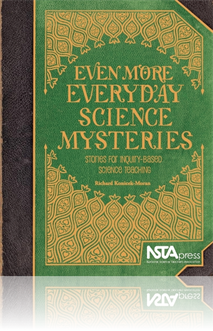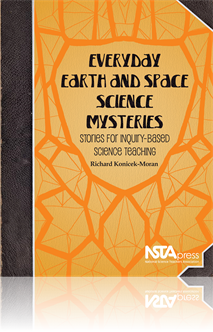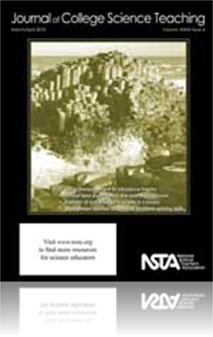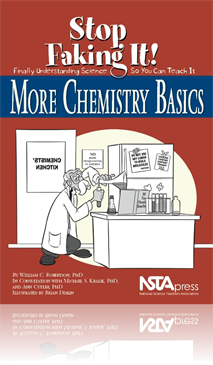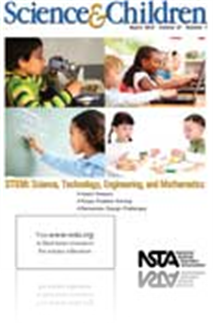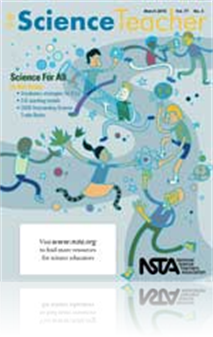All Resources
Book Chapter
Students may well have the usual “bigger is better” conception about comparing different items. Pumpkins are the perfect object to help engage students in investigative science and answer most of their questions by direct observation. ...
Book Chapter
Do your students believe that an insulating substance such as wool can actually produce heat? The story in this chapter is designed to motivate your students to let you know what they believe and then for them to be able to test their theories in the...
Book Chapter
Most children have a difficult time believing that air has mass and takes up space, so the concept of water vapor floating in the air is just as problematic. The story in this chapter helps provide an opportunity to explore this phenomenon and to lea...
Book Chapter
Some students are not aware that an object weighs as much as the sum of its parts. The story in this chapter has two purposes. One is to allow students to test their ideas about the distribution of weight, and the other is to help them realize that w...
Book Chapter
Rust is one of the most common of every day phenomena, but again, is probably one of the least understood by students. The story in this chapter attempts to get students and their teachers involved in some tests to see what they can learn about rust ...
Book Chapter
Children think of floating or buoyancy in several ways. The purpose of the story in this chapter is to motivate students to solve the mystery of why objects bob up and down in carbonated drinks. ...
Book Chapter
Using the Book and the Stories
It is often difficult for overburdened teachers to develop lessons or activities that are compatible with the everyday life experiences of their students. A major premise of this book is that if students can see the real-life implications of science ...
Book Chapter
Using the Book in Different Ways
Although the book was originally designed for use with K–8 students by teachers or adults in informal settings, it became obvious that a book containing stories and content material for teachers who are intent on teaching in an inquiry mode had oth...
Book Chapter
There is currently a strong effort to combine science and literacy, because a growing body of research stresses the importance of language in learning science. Discussion, argumentation, discourse of all kinds, group consensus, and social interaction...
Book Chapter
Your students will probably not be aware of the amount of water that covers the Earth’s surface. The story in this chapter will help introduce students not only to a clearer idea of the characteristics of our planet, but also to the concepts of pro...
Book Chapter
It is not difficult to understand that students may have a misconception that the clocks we use are directly related to Sun time and that changing the clocks will alter the Sun-Earth time relationship. This chapter and story deal with this misconcept...
Book Chapter
Students may have the idea that all mountains are volcanoes and were formed by eruptions. The story in this chapter brings up questions about the geology of mountains and the weathering and erosion that takes place as nature breaks down the higher la...
Book Chapter
It is not difficult to understand that students may have a misconception that the clocks we use are directly related to Sun time and that changing the clocks will alter the Sun-Earth time relationship. This chapter and story deal with this misconcept...
Journal Article
In October of 2009, the Committee on Equal Opportunities in Science and Engineer (CEOSE) held a symposium on Women of Color in STEM (science, technology, engineering, and mathematics; NSF-OAI). The symposium featured data pertaining to Asian, African...
Book Chapter
The title of this chapter is a compact way of saying that it covers two separate branches of chemistry. The first is electrochemistry and the second is the interaction of light with matter. An entire chapter could be spent on each of these areas, but...
Book Chapter
This is the second chemistry book in the Stop Faking It! series—the first one is Chemistry Basics. This book introduces new concepts and expands on many of the concepts presented in the first book, hence the author felt it would be helpful to begi...
Book Chapter
This chapter is about states of matter and a section of chemistry called thermodynamics which is the inspiration (or lack thereof) for the chapter title. The chapter might seem just a bit disconnected from the content in the rest of the book, but it�...
Book Chapter
To begin this chapter, you need to picture electrons in atoms as residing in orbitals—those fuzzy things that can be spherical, dumbbell-shaped, or even ring-shaped. The author addresses orbitals and why they’re fuzzy and then deals with how the ...
Book Chapter
The basics of chemical reactions were covered in the first chemistry book, including how to write and balance chemical equations that represent those reactions. There is also a quick review of chemical reactions in Chapter 1 of this book. We’re goi...
Book Chapter
Half a Life is Better Than None
Most of chemistry deals with chemical reactions and, hence, with how electrons in atoms behave either in single atoms or when those atoms get together with other atoms. There is a branch, though, that deals with the nuclei of atoms—and that’s wha...
Book Chapter
It would be impossible to investigate even a fraction of organic chemistry in this book, so in this chapter the author goes over a few things that will complement the limited organic chemistry in the first book. This is not a comprehensive chapter on...
NSTA Press Book
Even More Everyday Science Mysteries: Stories for Inquiry-Based Science Teaching
What are the odds of a meteor hitting your house? What are “warm” clothes anyway? Do you get “more” sunlight from Daylight Saving Time? Everyone loves a good mystery and these unfold in the 15 stories presented in Even More Everyday Science M...
By Richard Konicek-Moran
Journal Article
Science 101: How are skyscrapers designed?
Building a structure that stands hundreds or thousands of feet in the air incorporates all aspects of the design process. There are clear goals, constraints, and trade-offs. Here the author does his best to describe these three with respect to skyscr...
Journal Article
Science Sampler: Bringing scientific inquiry alive using real grass shrimp research
This lesson was developed for middle school students using actual research on grass shrimp (Palaemonetes pugio) to illustrate the process of a scientific investigation. The research was conducted at Savannah State University and funded by the Nationa...
Journal Article
Editor’s Corner: Closing the Academic Achievement Gap
This issue of The Science Teacher marks our 15th annual issue devoted to the theme of “Science for All.” Ideas for reaching out to underrepresented groups are more important now than ever, as our classrooms become increasingly diverse. Despite so...
Journal Article
A Writing and Ethics Component for a Quantum Mechanics, Physical Chemistry Course
A writing-across-the-curriculum and ethics component is presented for a second-semester, physical chemistry course. The activity involves introducing ethical issues pertinent to scientists. Students are asked to read additional material, participate ...
Journal Article
A new challenge in science education at the university level is the implementation of effective field components within online courses. In nationwide online graduate geoscience courses composed of practicing teachers (N = 130), Google Earth laborator...
Journal Article
Science 2.0: Probeware—Illuminating the Invisible
Probeware is the combination of sensors and software connected to a computer or handheld device. At the heart of probeware is a digital sensor that measures a particular physical parameter. One or more sensors are plugged into an interface, a calcula...
Journal Article
Can students build a house that is cost effective and strong enough to survive strong winds, heavy rains, and earthquakes? First graders in Ms. Peter’s classroom worked like engineers to answer this question. They participated in a design challenge...
Journal Article
“Watch out, the stove will burn you,” “Ooh, ice cream headache!” Students construct their conceptions about heat and temperature through their own intuitions about daily life experiences. As a result, misconceptions can be born from these con...
Journal Article
Developing Problem-Solving Skills of Students Taking Introductory Physics via Web-Based Tutorials
Science teaching and learning can be made both engaging and student-centered using pedagogical, computer-based learning tools. The authors have developed self-paced interactive problem-solving tutorials for introductory physics. These tutorials can p...
Journal Article
In the first months of 2009, the International Year of Astronomy, the authors developed an educational project for middle-level students connected with the first astronomical discoveries that Galileo Galilei (1564–1642) made 400 years ago. The proj...
Journal Article
The Prepared Practitioner: Universal Design
According to the Center of Universal Design, universal design (UD) is “the design of products and environments to be usable by all people, to the greatest extent possible, without the need for adaptations or specialized design” (Burgstahler 2009)...
Journal Article
This study examined the nature of college students’ interest or lack of interest in science and the factors to which they attributed their interest or lack of interest....
Journal Article
Green Science: Investigating green—Creating surveys to answer questions
Being green means different things to different people. Some suggest that being green means saving energy, not wasting paper towels, going solar, harnessing wind, using less fertilizer, or buying products that are organically grown. Given that being ...
Journal Article
In 2007 and 2008, three science teachers participated in research “cruises” to the Juan de Fuca Ridge off the coast of Washington. This opportunity was made possible by a National Science Foundation (NSF) CAREER grant awarded to Daniela Di Iorio,...



